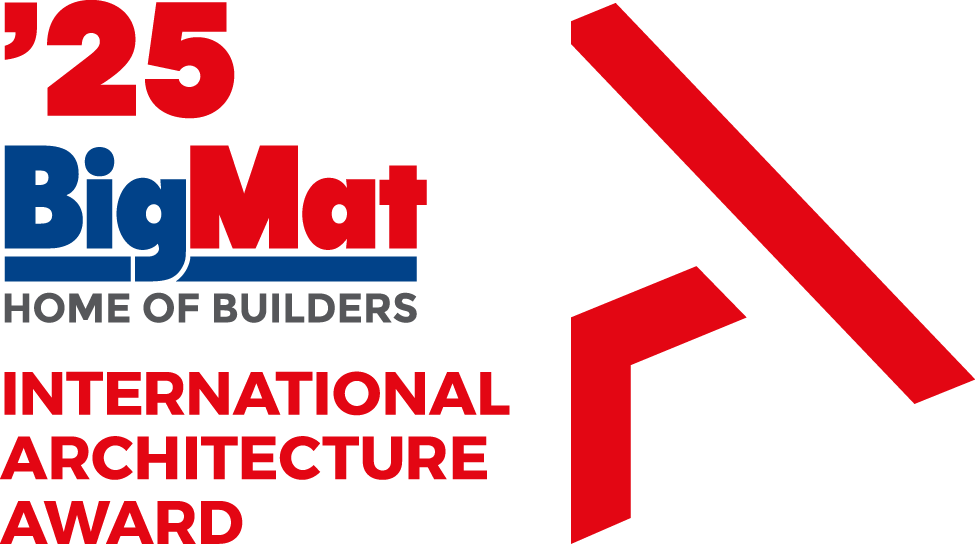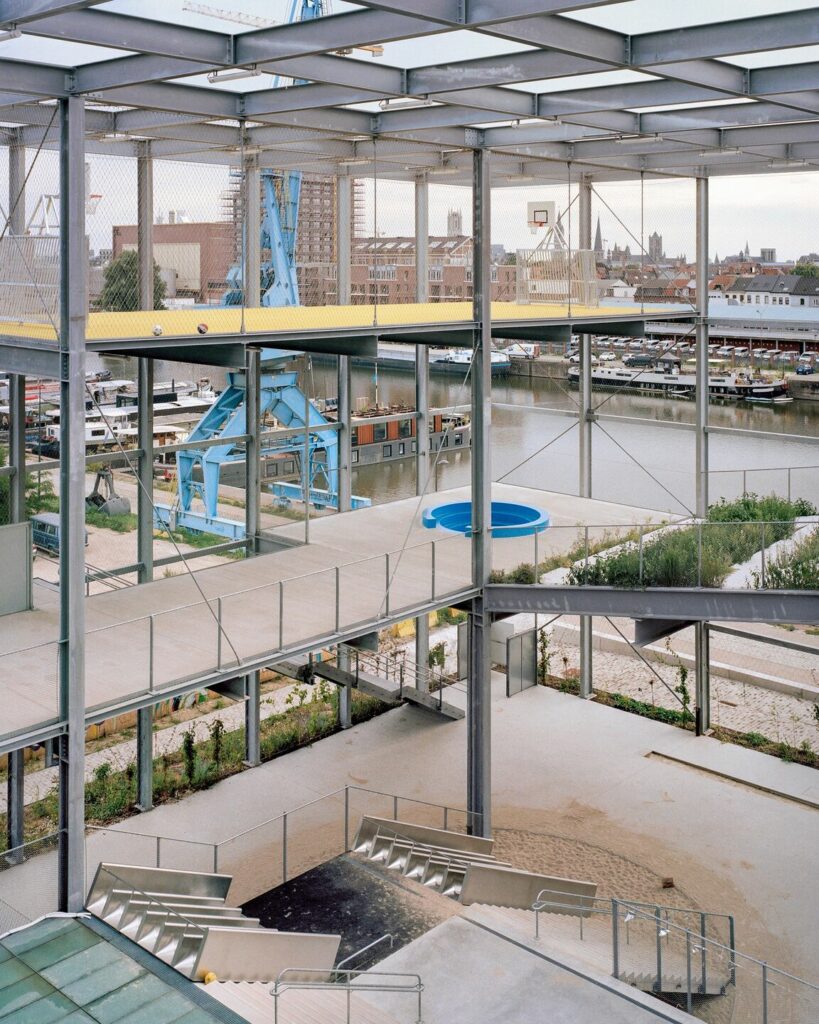Melopee School, completed in 2020 by the Belgian architect, was awarded with the highest honour in the latest BigMat International Architecture Award and has recently won the Brussels Architecture Prize in the „Extra Muros“ category.

Melopee School by XDGA followed the Power Plant for the “FOZ TUA” DAM by Souto de Moura, the FRAC Nord-Pas de Calais art center by Lacaton&Vassal, the office building by Alberto Campo Baeza and the Elishout Kitchen Tower Campus by Xaveer De Geyter as Grand Prize of the biannual award. The fifth edition of the BigMat International Architecture Award rewards European architecture with one Grand Prize (30.000€), six National Prizes (5.000€ each prize), seven Finalist Prizes (1.500€ each prize), and one Special Mention for Small-Scale Projects (1.500€ prize).
Melopee Multifunctional School Building
XDGA – Xaveer De Geyter Architects
BigMat International Architecture Award Grand Prize’21
Brussels Architecture Prize Extra Muros Category
Project location: Ghent, Belgium
Programme: Kindergarten (96 children), primary school (144 children), after-school care (56 children), daycare (28 children), sports hall
Procedure: International design competition
Client: soGent
Completion: 1/02/2020
Total floor area: 7680 m²
Budget (€, excl. VAT and fees): 10 000 000 €
Stability engineer: Ney & Partners
Technical engineer: Studiebureau Boydens
Acoustics: Daidalos-Peutz
The project by the award-winning architect aims “to offer a notion of centrality to the linear plan developed by O.M.A. in which green open pockets alternate with dense construction […]. In order to counter the lack of space, deal with the inside-outside complexity of programs and allow for the public path to pass, the maximum building envelope is divided in two halves: one compact building housing all interior functions, and an outside space […]. In between both, and under a first level playground realized in glass tiles, the path crosses the volume. A galvanized steel skeleton unifies the two halves. On the side of the interior volume, the façades of the building are designed as a patchwork of opaque and translucent polycarbonate, glass, and aluminium louvres. The outside structure will be overgrown with vegetation climbing along a steel mesh, in which some large ‘windows’ are cut out […]”

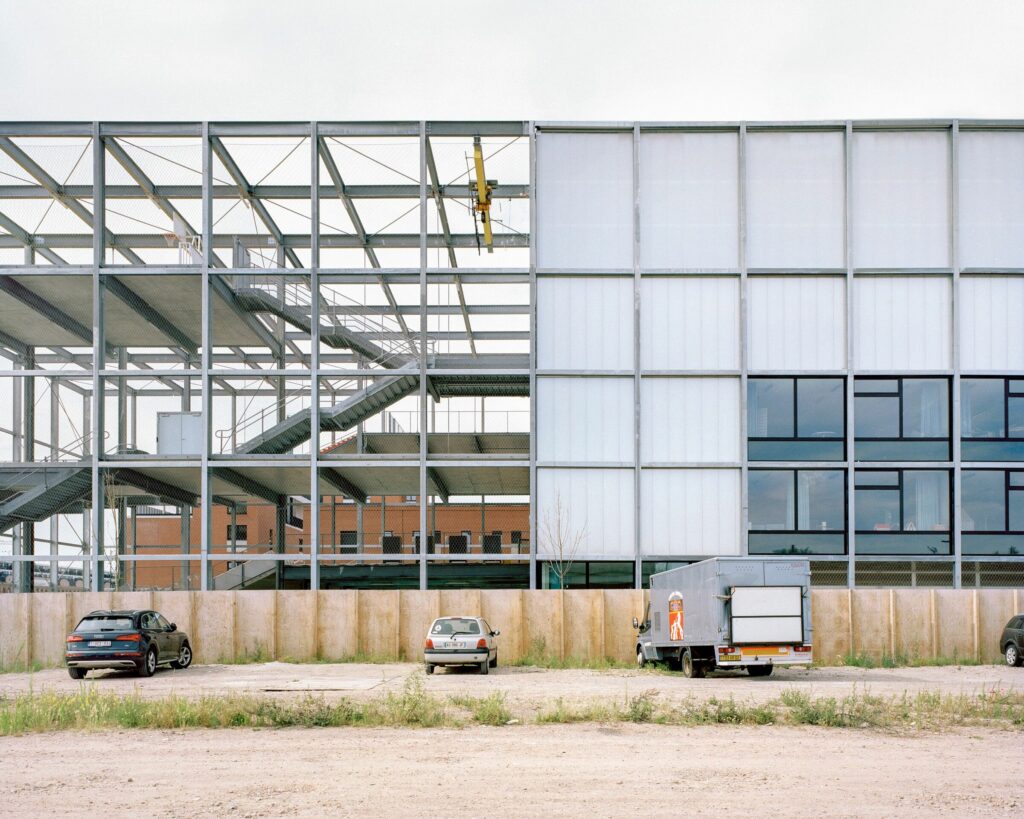
The design of the Stadsgebouw on the Oude Dokken in Ghent was a difficult puzzle. The programme, a multipurpose building with a primary school, a crèche, after-school care facilities and a sports hall, hardly fit on the narrow plot. Moreover, according to OMA’s master plan, a ‘play ribbon’ had to run through the site. XDGA formulated a surprising answer.

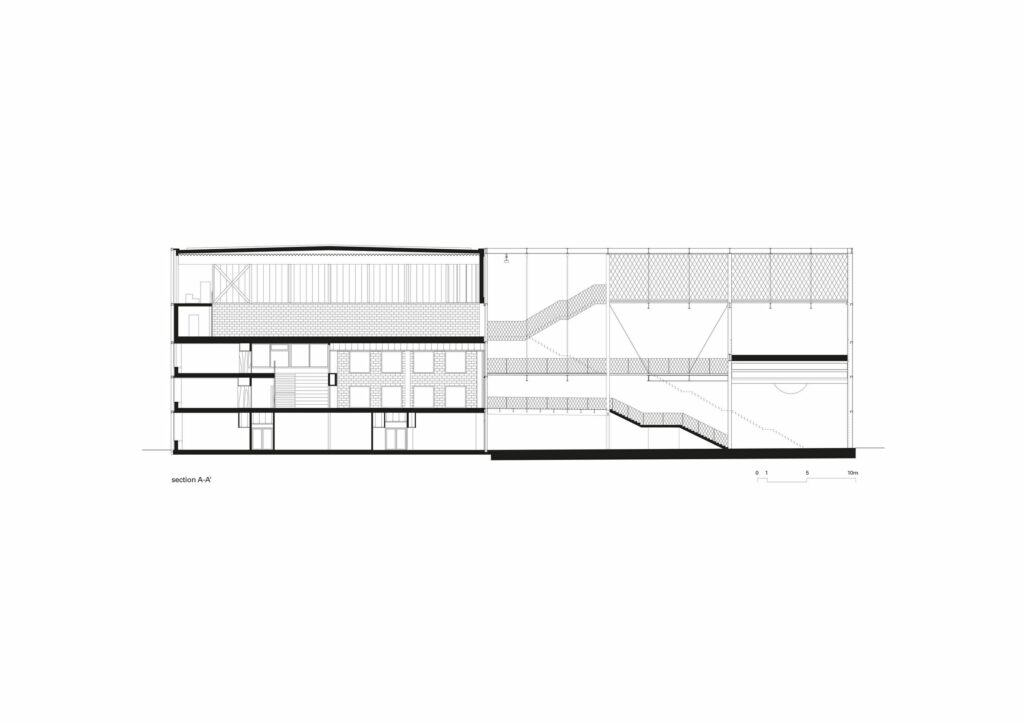
In 2004 OMA proposed the ‘brochette model’ to convert this former harbour area, squeezed between Koopvaardijlaan and the Oude Dokken, into a full-fledged urban district. In this model, different programmes are skewered together – in parallel strips and at right angles to the water – by an internal street, the ‘play ribbon’. Only the plot of the Stadsgebouw, which from now on will be called Melopee, occupies the entire depth of the building block. But the play ribbon should run through there too.


In a vision note accompanying the competition design for this project, XDGA stated that it was not obvious to organize the programme of school and sports hall by leaving open outdoor spaces from the building volume, all the less so since the city wanted a ‘community’ school that also serves the neighbourhood after school hours. This requires a separate access for various classrooms and the sports hall. XDGA untangled the knot by radically separating interior spaces (such as classrooms or the refectory) from exterior spaces (such as playgrounds, an exterior space for the crèche, but also a terrace for the sports hall’s cafeteria or a ‘sports cage’).
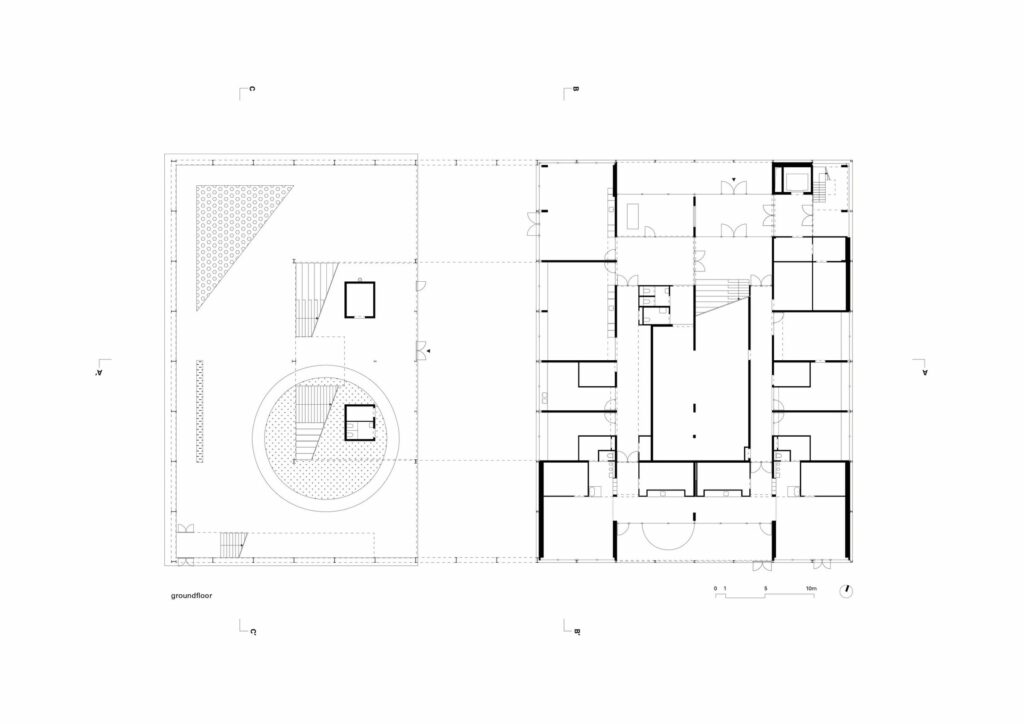

A compact box measuring 31 by 40 metres encompasses all the interior spaces. The ground floor includes the crèche and management offices. A wide staircase then leads from the communal entrance on the north side to nursery classrooms and after-school care on the first floor, and the primary school on the second floor. A spacious, double-height refectory on the first floor forms the heart of this school. Despite the compact stacking, the wide corridors and the staircase offer many possibilities for (collective) activities outside the classroom. The building feels like a spacious jacket with many pockets. On the other hand, the equally double-height sports hall on top can be reached from within the building by means of a separate stairwell and lift shaft.

Melopee School, XDGA – Xaveer De Geyter Architects © Maxime Delvaux 
Melopee School, XDGA – Xaveer De Geyter Architects © Maxime Delvaux
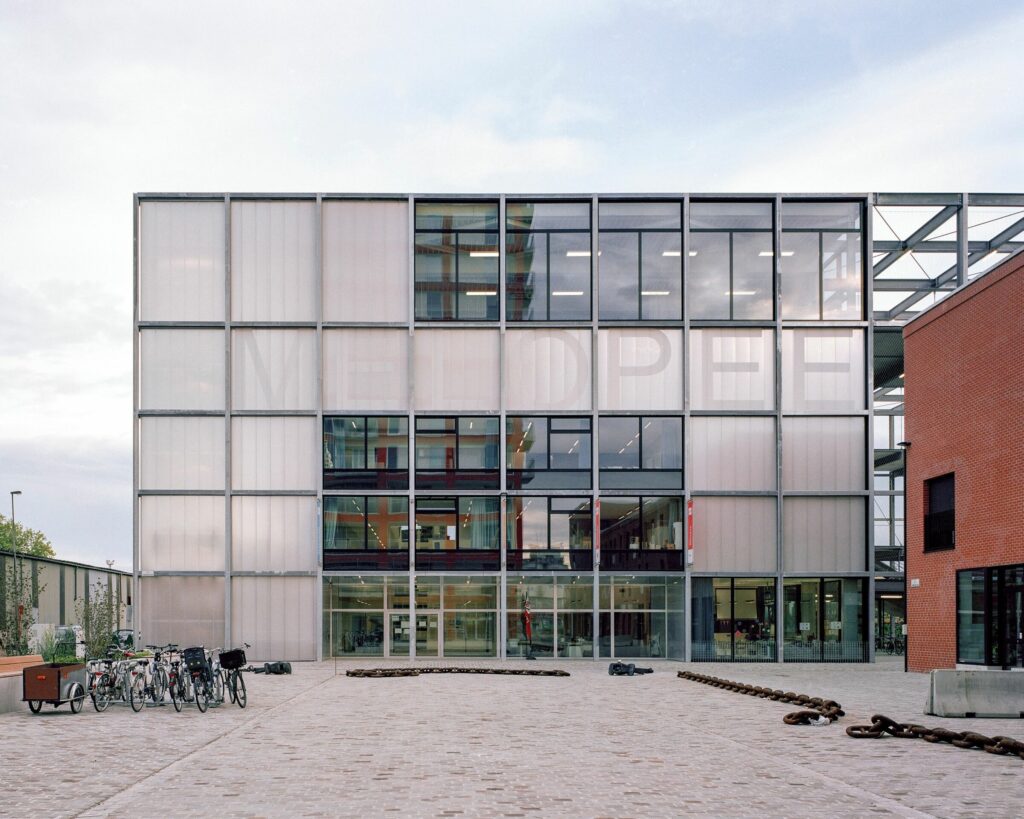
Opposite that ‘full’ box is a ‘hollow’ one: a huge cage of galvanized steel columns and beams. The ‘walls’ consist of wire cloth and climbing plants, with windows positioned in it here and there. Within the box, floors, stairs and bridges create a 3D puzzle of outdoor spaces, such as playgrounds or the ‘sports cage’. In this way, every part of the programme in the building is directly connected to the corresponding outdoor space, while an outdoor staircase provides an additional access to the primary school playground and the sports hall.

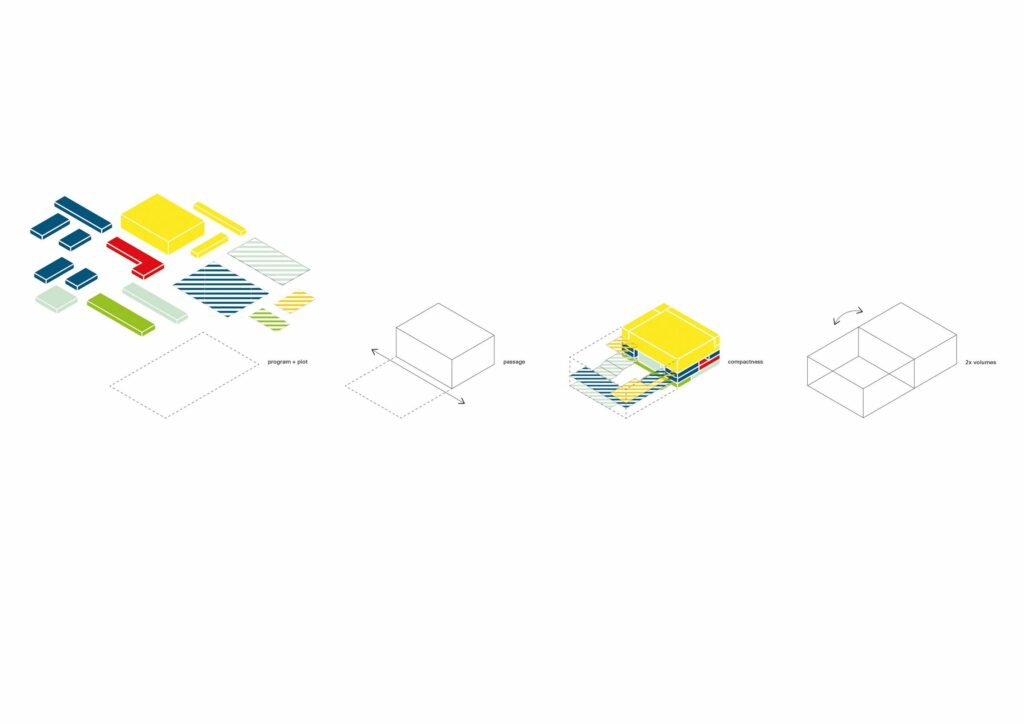
A central open area on the first floor forms the heart of this ‘hollow box’, like a reflection of the refectory in the ‘full box’. The design emphasizes that spatial reflection between ‘hollow’ and ‘full’ because the grid of the outside cage also runs around the closed box. Incidentally, this closed box does not feel closed at all, because the walls consist only of window frames or translucent polycarbonate hollow-core slabs. These also continue in front of closed wall parts, disappearing in the process, as it were.
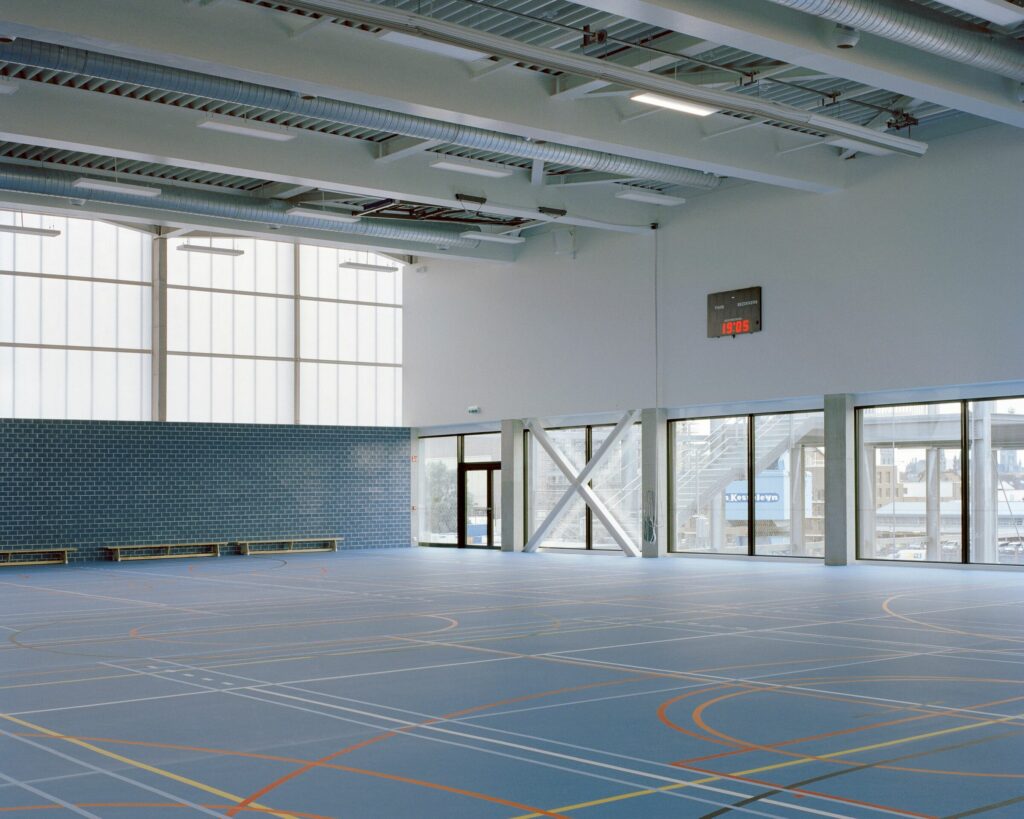

After the competition, not too much was altered in the design. The most important change is that the crèche was moved to the south side of the building, with a view of the future park. Its outdoor space was left open in the base of the building and is therefore no longer part of the ‘hollow box’. As a result, the play ribbon can skim along the ‘full’ building like a wide, straight passageway measuring 12 metres under the glass ‘platform’ of the refectory. The school’s conference room and the staff room look out onto it on one side, while the toddlers play on the other. As such, the play ribbon represents a concrete link between the world of the school and the city.
After the competition, the design was also given more architectural detailing. The ‘hollow box’ was fleshed out with greater diversity and imagination. The decor of the refectory with glazed, bright-pink perforated bricks not only contributes to the acoustics, but also creates a cheerful atmosphere. The sports hall is truly amazing. Here too, glazed acoustic bricks dominate, but it is the surprisingly limited height of the roof beams – necessary in order to remain within the permitted building height – that is the main surprise. Laurent Ney of Ney & Partners used steel boxes to pull off this trick.
